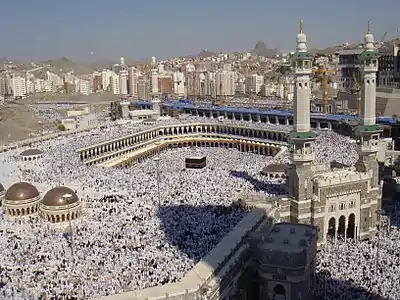Islamic ornament
Islamic ornament is the use of decorative patterns in Islamic art. They can be broadly divided into the arabesque, using curving plant-based elements, geometric patterns with straight lines or regular curves, and calligraphy, consisting of religious texts with stylised appearance, used both decoratively and to convey meaning. All three often involve elaborate interlacing. The three types of ornament are often used together.
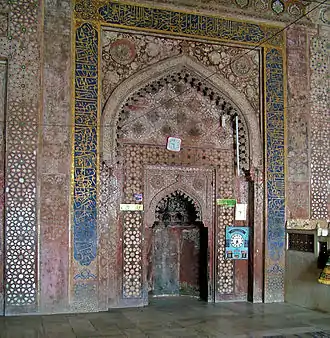
Islamic decoration has had a significant influence on European decorative artforms, especially as Western arabesque.
Overview
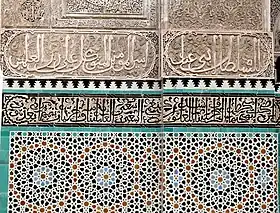
Islamic art mostly avoids figurative images to avoid becoming objects of worship.[1][2] This aniconism in Islamic culture caused artists to explore non-figural art, and created a general aesthetic shift toward mathematically-based decoration.[3] The Islamic geometric patterns derived from simpler designs used in earlier cultures: Greek, Roman, and Sasanian. They are one of three forms of Islamic decoration, the others being the arabesque based on curving and branching plant forms, and Islamic calligraphy; all three are frequently used together, in forms such as mosaic, stucco, brickwork, and ceramics, to decorate religious buildings and objects.[4][5][6][7]
Authors such as Keith Critchlow[lower-alpha 1] argue that Islamic patterns are created to lead the viewer to an understanding of the underlying reality, rather than being mere decoration, as writers interested only in pattern sometimes imply.[8][9] In Islamic culture, the patterns are believed to be the bridge to the spiritual realm, the instrument to purify the mind and the soul.[10] David Wade[lower-alpha 2] states that "Much of the art of Islam, whether in architecture, ceramics, textiles or books, is the art of decoration – which is to say, of transformation."[11] Wade argues that the aim is to transfigure, turning mosques "into lightness and pattern", while "the decorated pages of a Qur’an can become windows onto the infinite."[11] Against this, Doris Behrens-Abouseif[lower-alpha 3] states in her book Beauty in Arabic Culture that a "major difference" between the philosophical thinking of Medieval Europe and the Islamic world is exactly that the concepts of the good and the beautiful are separated in Arabic culture. She argues that beauty, whether in poetry or in the visual arts, was enjoyed "for its own sake, without commitment to religious or moral criteria".[12]
Arabesque
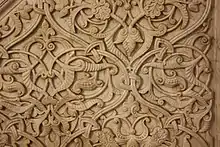
The Islamic arabesque is a form of artistic decoration consisting of "rhythmic linear patterns of scrolling and interlacing foliage, tendrils" or plain lines,[13] often combined with other elements. It usually consists of a single design which can be 'tiled' or seamlessly repeated as many times as desired.[14]
Geometric patterns
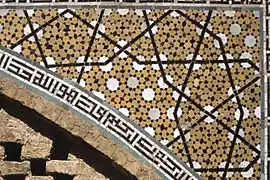
The geometric designs in Islamic art are often built on combinations of repeated squares and circles, which may be overlapped and interlaced, as can arabesques, with which they are often combined, to form intricate and complex patterns, including a wide variety of tessellations. These may constitute the entire decoration, may form a framework for floral or calligraphic embellishments, or may retreat into the background around other motifs. The complexity and variety of patterns used evolved from simple stars and lozenges in the ninth century, through a variety of 6- to 13-point patterns by the 13th century, and finally to include also 14- and 16-point stars in the sixteenth century.[4][15][5][16]

Geometric patterns occur in a variety of forms in Islamic art and architecture including kilim carpets,[17] Persian girih[18] and Moroccan zellige tilework,[19] muqarnas decorative vaulting,[20] jali pierced stone screens,[21] ceramics,[22] leather,[23] stained glass,[24][25] woodwork,[26] and metalwork.[27][28]
Calligraphy
Calligraphy is a central element of Islamic art, combining aesthetic appeal and religious message. Sometimes it is the dominant form of ornament; at other times it is combined with arabesque.[29] Calligraphy is used to ornament buildings such as mosques, madrasahs, and mausoleums; wooden objects such as caskets; and ceramics such as tiles and bowls.[30][31]

Influence on Western ornament
A Western style of ornament based on Islamic arabesque developed in Europe, starting in late 15th century Venice; it has been called either moresque or western arabesque. It has been used in a great variety of the decorative arts, especially in book design and bookbinding.[32] More recently, William Morris of the Arts and Crafts movement was influenced by all three types of Islamic ornament.[33]
Notes
- Critchlow is a professor of architecture, and the author of a book on Islamic patterns.
- Wade is the author of a series of books on pattern in various artforms.
- Behrens-Abouseif is a professor of the history of art and architecture at SOAS.
References
- Bouaissa, Malikka (27 July 2013). "The crucial role of geometry in Islamic art". Al Arte Magazine. Retrieved 1 December 2015.
- Bonner, Jay (2017). Islamic geometric patterns : their historical development and traditional methods of construction. New York: Springer. p. 1. ISBN 978-1-4419-0216-0. OCLC 1001744138.
- Bier, Carol (Sep 2008). "Art and Mithãl: Reading Geometry as Visual Commentary". Iranian Studies. 41: 9. doi:10.1080/00210860802246176. JSTOR 25597484. S2CID 171003353.
- "Geometric Patterns in Islamic Art". Heilbrunn Timeline of Art History. Metropolitan Museum of Art. Retrieved 1 December 2015.
- Hankin, Ernest Hanbury (1925). The Drawing of Geometric Patterns in Saracenic Art. Memoirs of the Archaeological Survey of India No. 15. Government of India Central Publication Branch.
- Baer 1998, p. 41.
- Clevenot 2017, pp. 7-8, 63-112.
- Critchlow, Keith (1976). Islamic Patterns : an analytical and cosmological approach. Thames and Hudson. ISBN 0-500-27071-6.
- Field, Robert (1998). Geometric Patterns from Islamic Art & Architecture. Tarquin Publications. ISBN 978-1-899618-22-4.
- Ahuja, Mangho; Loeb, A. L. (1995). "Tessellations in Islamic Calligraphy". Leonardo. 28 (1): 41–45. doi:10.2307/1576154. JSTOR 1576154. S2CID 191368443.
- Wade, David. "The Evolution of Style". Pattern in Islamic Art. Retrieved 12 April 2016.
Much of the art of Islam, whether in architecture, ceramics, textiles or books, is the art of decoration – which is to say, of transformation. The aim, however, is never merely to ornament, but rather to transfigure. ... The vast edifices of mosques are transformed into lightness and pattern; the decorated pages of a Qur’an can become windows onto the infinite. Perhaps most importantly, the Word, expressed in endless calligraphic variations, always conveys the impression that it is more enduring than the objects on which it is inscribed.
- Behrens-Abouseif, Doris (1999). Beauty in Arabic Culture. Markus Wiener. pp. 7–8. ISBN 978-1-558-76199-5.
- Fleming, John; Honour, Hugh (1977). Dictionary of the Decorative Arts. Penguin. ISBN 978-0-670-82047-4.
- Robinson, Francis (1996). The Cambridge Illustrated History of the Islamic World. Cambridge University Press. ISBN 978-0-521-66993-1.
- Broug, Eric (2008). Islamic Geometric Patterns. Thames and Hudson. pp. 183–185, 193. ISBN 978-0-500-28721-7.
- Abdullahi, Yahya; Bin Embi, Mohamed Rashid (2013). "Evolution of Islamic geometric patterns". Frontiers of Architectural Research. 2 (2): 243–251. doi:10.1016/j.foar.2013.03.002.
- Thompson, Muhammad; Begum, Nasima. "Islamic Textile Art and how it is Misunderstood in the West – Our Personal Views". Salon du Tapis d'Orient. Retrieved 3 December 2015.
- "Gereh-Sazi". Tebyan. 20 August 2011. Retrieved 4 December 2015.
- Njoku, Raphael Chijioke (2006). Culture and Customs of Morocco. Greenwood Publishing Group. p. 58. ISBN 978-0-313-33289-0.
- Tabbaa, Yasser. "The Muqarnas Dome: Its Origin and Meaning" (PDF). Archnet. pp. 61–74. Archived from the original (PDF) on 8 December 2015. Retrieved 2 December 2015.
- "For Educators: Geometric Design in Islamic Art: Image 15". Metropolitan Museum of Art. Retrieved 2 December 2015.
- "Geometric Decoration and the Art of the Book. Ceramics". Museum with no Frontiers. Retrieved 7 December 2015.
- "Geometric Decoration and the Art of the Book. Leather". Museum with no Frontiers. Retrieved 7 December 2015.
- King, David C. King (2006). Azerbaijan. Marshall Cavendish. p. 99. ISBN 978-0-7614-2011-8.
- Sharifov, Azad (1998). "Shaki Paradise in the Caucasus Foothills". Azerbaijan International. 6 (2): 28–35.
- Gereh-Sāzī. Encyclopaedia Iranica. Retrieved 2 December 2015.
- Baer, Eva (1983). Metalwork in Medieval Islamic Art. SUNY Press. pp. 122–132. ISBN 978-0-87395-602-4.
- Gibb, Sir Hamilton Alexander Rosskeen (1954). The Encyclopaedia of Islam. Brill Archive. pp. 990–992. GGKEY:N71HHP1UY5E.
- Department of Islamic Art. "Calligraphy in Islamic Art" In Heilbrunn Timeline of Art History. New York: The Metropolitan Museum of Art (October 2001)
- Mozzati, Luca (2010). "Calligraphy: The Form of the Divine Word". Islamic Art. Prestel. pp. 52–59. ISBN 978-3-7913-4455-3.
- "Bowl with Kufic Calligraphy". Brooklyn Museum. Retrieved 30 September 2020.
- Harthan, John P. (1961). Bookbinding (2nd ed.). HMSO for the Victoria and Albert Museum. pp. 10–12. OCLC 220550025.
- "A Place in Pattern: Islamic Art and its Influence in British Arts & Crafts". William Morris Society. 2020. Archived from the original on 3 October 2020. Retrieved 14 October 2020.
.jpeg.webp)
